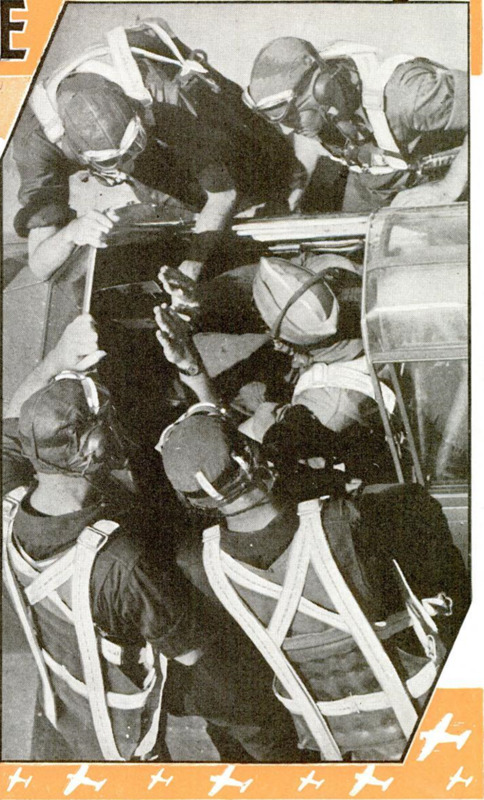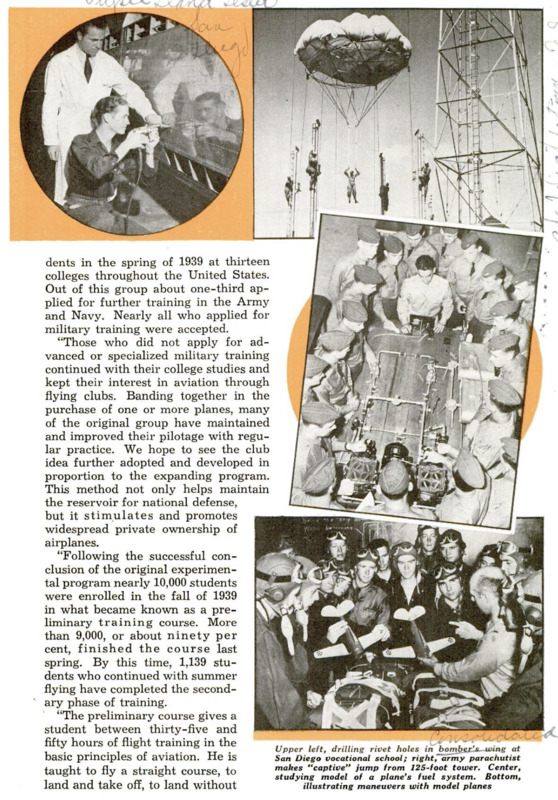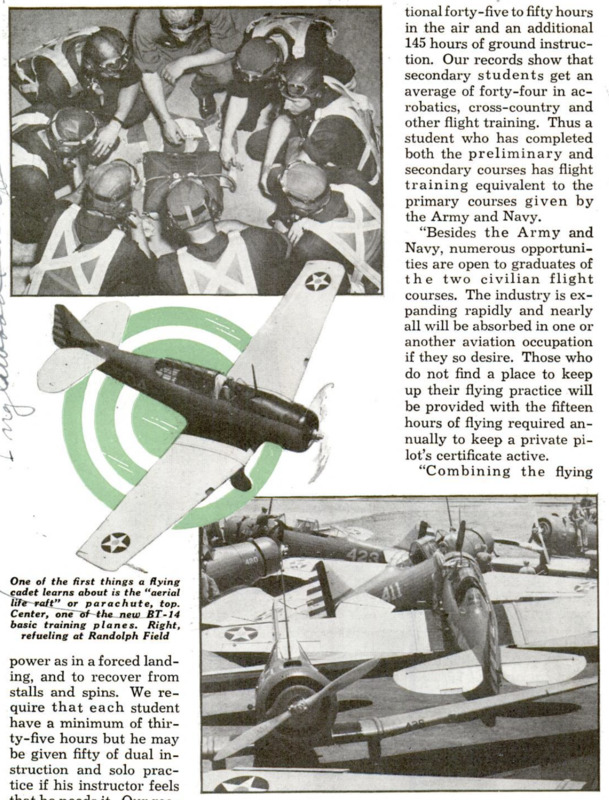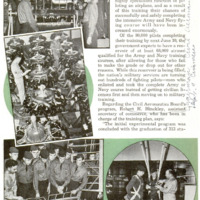PlLOTS by the thosands and ground crew specialists by the tens of| thousands will be needed to man and service the 50,000 planes a year which experts say are needed to defend this country. In this long-range program, the Civil Acronautics Board has undertaken the job of building up a huge reservoir of civilian pilots, qualifying them for specialized training which will convert them quickly into fighting pilots, By June 30,1941, eighty thousand will have completed civilian training. Twenty-five thousand already have been graduated. As a result of the Civil Aeronautics program, the United States will not be faced with the unhappy situation which existed at the time of the World War when it became necessary to train military pilots with such terrific haste and cost in human life. The pressure was so great then that more student pilots were killed in the training process in American camps than were killed afterward in air battles over France. Those who complete the preliminary and secondary courses of the training program will have had the equivalent of the military primary training. They will be young men who have cleared the first hurdles, who have demonstrated their mental and physical fitness for the highly specialized function of piloting an airplane, and as a result of this training their chances of successfully and safely completing the intensive Army and Navy flying course will have been increased enormously. Of the 80,000 pilots completing their training by next June 30, the government expects to have a reservoir of at least 68,000 airmen qualified for the Army and Navy training courses, after allowing for those who fail to make the grade or drop out for other reasons. While this reservoir is being filled, the nation’s military services are turning out hundreds of fighting pilots - men who enlisted and took the complete Army or Navy course instead of getting civilian licenses first and then moving on to military training. Regarding the Civil Aeronautics Board's program, Robert H. Hinckley, assistant secretary of commerce, who has been in charge of the training plan, says: “The initial experimental program was concluded with the graduation of 313 students in the spring of 1939 at thirteen colleges throughout the United States. Out of this group about one-third applied for further training in the Army and Navy. Nearly all who applied for military training were accepted. “Those who did not apply for advanced or specialized military training continued with their college studies and kept their interest in aviation through flying clubs. Banding together in the purchase of one or more planes, many of the original group have maintained and improved their pilotage with regular practice. We hope to see the club idea further adopted and developed in proportion to the expanding program. This method not only helps maintain the reservoir for national defense, but it stimulates and promotes widespread private ownership of airplanes. “Following the successful conclusion of the original experimental program nearly 10,000 students were enrolled in the fall of 1939 in what became known as a preliminary training course. More than 9,000, or about ninety percent, finished the course last spring. By this time, 1,139 students who continued with summer flying have completed the second- ary phase of training. “The preliminary course gives a student between thirty-five and fifty hours of flight training in the basic principles of aviation. He is taught to fly a straight course, to land and take off, to land without power as in a forced landing, and to recover from stalls and spins. We require that each student have a minimum of thirty-five hours but he may be given fifty of dual instruction and solo practice if his instructor feels that he needs it. Our records show that the average preliminary student gets thirty-seven hours of dual and solo practice. The course also includes seventy-two hours of ground instruction in the theory of flight and other pertinent subjects. “The secondary course includes an additional forty-five to fifty hours in the air and an additional 145 hours of ground instruction. Our records show that secondary students get an average of forty-four in acrobatics, cross-country and other flight training. Thus a student who has completed both the preliminary and secondary courses has flight training equivalent to the primary courses given by the Army and Navy. “Besides the Army and Navy, numerous opportunities are open to graduates of the two civilian flight courses. The industry is expanding rapidly and nearly all will be absorbed in one or another aviation occupation if they so desire. Those who do not find a place to keep up their flying practice will be provided with the fifteen hours of flying required annually to keep a private pilot’s certificate active. “Combining the flying schools, the flying clubs and other efforts, we aim to establish an active flight-training program on virtually every airport in the United States where it will not conflict with airline traffic. “During the past school year the training program operated with thorough effective ness in centers distributed through every state in the union, Alaska, Hawaii and Puerto Rico. At these centers 538 private commercial operators were organized to furnish the controlled and proven course of flying instruction. Facilities for ground-school instruction were made available at 435 colleges and universities. In seventy-five communities training was conducted on a non-college basis and graduated 750 students. More than 400,000 hours of flight training were given in the combined program. Colleges participating this fall total 499 in 202 communities. “Civil Aeronautics recently graduated seventy-seven students from two experimental schools employing new types of aircraft designed to eliminate the spinning characteristics of the conventional airplane. The spinproof airplane, besides great inherent stability, has a simplified control system and is therefore easier to fly. At the same time it is less maneuverable than the conventional type and is therefore unadaptable to acrobatics and other military requirements. The spin-proof airplane is intended essentially as air transportation for the individual who would like to own and pilot his own airplane but does not have the time to apply himself to the more exacting pilot requirements of other types. “Applicants for the government’s preliminary flying course must be between the ages of eighteen and twenty-six and must pass a rigid physical examination. It is intended to be equivalent to the Army and Navy medical requirements. College students must meet the educational requirements of their schools. Non-college flight students are required to attain a high standing in the ground course given prior to their flight training. At this time there are approximately 15,000 non-college applicants competing for approximate1y 2,000 vacancies. “All applicants for the secondary flight course are required to pass the same examination required of applicants for training in the military aviation schools. “New impetus recently was given the program by associating 1,500 experienced, pilots with rated instructors who are gradually teaching pilots of the ‘old school’ the new methods of instruction. By this method we are greatly expanding our teaching staff. Another development contemplates a refresher course for thousands of pilots whose certificates of competency have elapsed, principally for want of practice. “Originally we did not intend to ‘refresh’ more than 5,000 of the pilots formerly licensed or certified. But there have been so many applications for renewed training we have revised this figure upward. Many seek the refresher course because of the new piloting technique developed during the years since they first soloed. In this group are airmen whose training consisted of nothing more than a check pilot who accompanied them, and kept them from getting hurt, while they actually taught themselves to fly. They hadno real instruction in acrobatics or other maneuvers.” For every Army and Navy pilot in the air, ten or more trained men on the ground are necessary. The Army Air Corps began training 31,000 enlisted men as mechanics and specialists last July 1. By June 30, 1941, it is estimated that the Air Corps will have 46,000 qualified enlisted specialists, trained at the three Air Corps technical schools and at seven civilian technical schools. The specialists include airplane mechanics, welders, metal workers, radio-men, parachute men, armorers, photographers, engine men, machinists, meteorologists, teletype operators, supply clerks and stenographers, Facilities of the civilian mechanics schools used by the Army Air Corps will be expanded. The Navy trains its own mechanics in its own schools. No aeronautical engineering training is provided under the Civilian Pilot Training program. Such courses can be obtained at some of the larger colleges and to some extent at certain of the commercial aviation schools. California Institute of Technology, in cooperation with Lockheed Aircraft Corporation, has a course which will prepare men for work in the industry within eight weeks. Following this college course, the men get an additional eight weeks training in the factory before they are permitted to join the engineering department. The course is open to general engineers who have a sound background and foundation upon which aeronautical training can be based. These men are paid while they learn and are guaranteed jobs upon completion of the course. Glenn L. Martin Company, another manufacturer of airplanes, has inaugurated a training school. Curricula include blueprint reading, drafting, engineering procedure, lettering, standard aeronautical practices and nomenclature and studies of handbooks and textbooks on Martin methods. Lectures deal with all phases of work the men will do when they are admitted as regular members of the engineering staff. “This course dovetails with a shop training course in the engineering department. The new engineers are sent into the factory for a time to learn the machine and craft operations. Transferred from one department to another, they do the actual work of building airplane parts and helping to assemble them. The students are on full pay while they attend school. Training for aviation mechanics is available at approved commercial aviation schools and some 200 public schools in sixty-eight cities offer approved aviation ground courses.








